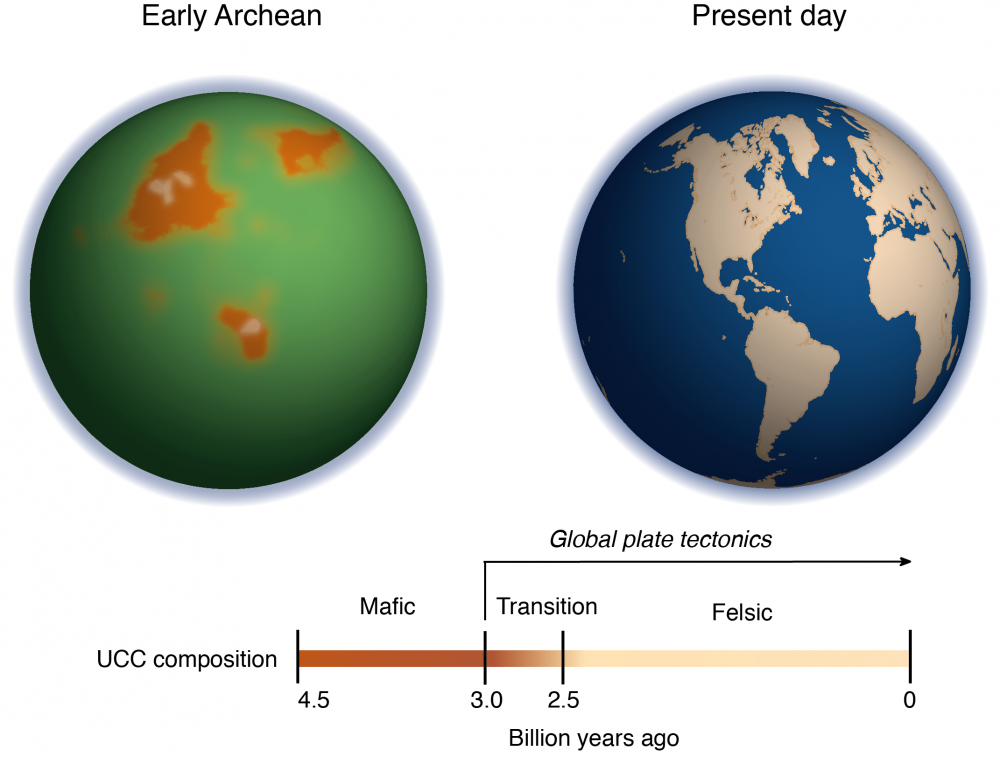
The Upper Crust

Large oceans of water and a rich atmosphere with just the right elements to support life set Earth apart from its close cousins in the solar system. Earth is also the only planet that has an active outer layer made of large tectonic plates that grind together and dip beneath each other. This activity gives rise to mountains, volcanoes, earthquakes and large continents of land.
Geologists have long debated when these processes — collectively known as plate tectonics — first got underway. Some scientists propose that the process began as early as 4.5 billion years ago, shortly after Earth’s formation. Others suggest a much more recent start, within the past 800 million years.
A new study from UC Santa Barbara and the University of Maryland (UMD) provides new geochemical evidence for a middle ground between these two extremes. An analysis of trace element ratios that correlate to magnesium content suggests that plate tectonics began about 3 billion years ago. The research results appear in the journal Science.
“This study provides first-order geochemical evidence for the onset of plate tectonics by tracking the composition of crust that sat above sea level and was exposed to weathering and erosion — the ancient equivalent of continental crust,” said senior author Roberta Rudnick, a newly appointed professor in the Department of Earth Science.
“The results also provide a further step in understanding when and how Earth’s continents formed, which is particularly significant because the data tell us what the average crust looked like in these ancient times, so it provides a global perspective,” she added. “There are a number of lines of evidence for the operation of plate tectonics in a particular region prior to 2.5 billion years, but these regional studies can’t reveal what’s happening globally.”
The research zeros in on a key characteristic of Earth’s crust that distinguishes it geochemically from other terrestrial planets in the solar system. Compared with Mars, Mercury, Venus and even our own moon, Earth’s continental crust contains less magnesium. Early in its history, however, Earth’s crust more closely resembled its cousins with a higher proportion of magnesium.
At some point, Rudnick noted, Earth’s crust evolved to contain more granite, a magnesium-poor rock that forms the basis of the planet’s continents. Many geoscientists agree that the start of plate tectonics drove this transition by dragging water underneath the crust, which is a necessary step to make granite.
“You can’t have continents without granite, and you can’t have granite without taking water deep into the Earth,” said Rudnick, formerly the chair of UMD’s geology department. She conducted this research with her UMD graduate student Ming Tang and visiting student Kang Chen of China University of Geosciences, Wuhan. “So at some point, plate tectonics began and subduction started bringing lots of water down into the mantle. The big question is, when did that happen?”
According to Tang and Rudnick, a logical approach to answering that question would be to examine the magnesium content in ancient rocks formed across a wide span of time, in order to determine when the transition toward low-magnesium crustal rocks began. However, this has proved difficult because the direct evidence — magnesium — has a habit of washing away into the ocean once rocks are exposed to the surface.
However, the investigators sidestepped this problem by looking at insoluble trace elements such as nickel, cobalt, chromium and zinc, which stay behind long after most of the magnesium has washed away. The researchers found that the ratios of these elements hold the key. Higher ratios of nickel to cobalt and chromium to zinc both correlate to higher magnesium content in the original rock.
“To our knowledge, we are the first to discover this correlation and use this approach,” said lead author Tang. “Because the ratios of these trace elements correlate to magnesium, they serve as a very reliable ‘fingerprint’ of past magnesium content.”
The research team compiled trace element data taken from a variety of ancient rocks that formed in the Archean eon, a time period between 2.5 and 4 billion years ago, and used it to determine the magnesium content in the rocks when they were first formed. They used these data to construct a computer model of the early Earth’s geochemical composition. This model accounted for how magnesium — specifically, magnesium oxide — content in the crust changed over time.
The results suggested that, 3 billion years ago, the Earth’s crust had roughly 11 percent magnesium oxide by weight. Within a half-billion years, that number had dropped to about 4 percent, which is very close to the 2 or 3 percent magnesium oxide seen today. This suggested that plate tectonics began about 3 billion years ago, giving rise to the continents that exist now.
“It’s really kind of a radical idea, to suggest that continental crust in the Archean had that much magnesium,” said Rudnick, pointing out that Tang was the first to work out the correlation between trace element ratios and magnesium. “Ming’s discovery is powerful because he found that trace insoluble elements correlate with a major element, allowing us to address a long-standing question in Earth history.”
“Because the evolution of continental crust is linked to many major geological processes on Earth, this work may provide a basis for a variety of future studies of Earth history, including crust-mantle interactions, atmospheric evolution, ocean chemistry and life on Earth,” said Tang. “For example, weathering of this magnesium-rich crust may have delivered chemical packages that are distinct from today into the ocean, where life on early Earth evolved. As for the onset of plate tectonics, I don’t think this study will close the argument, but it certainly adds a compelling new dimension to the discussion.”



